Compex Vitality User Manual [en, de, es, fr, it]
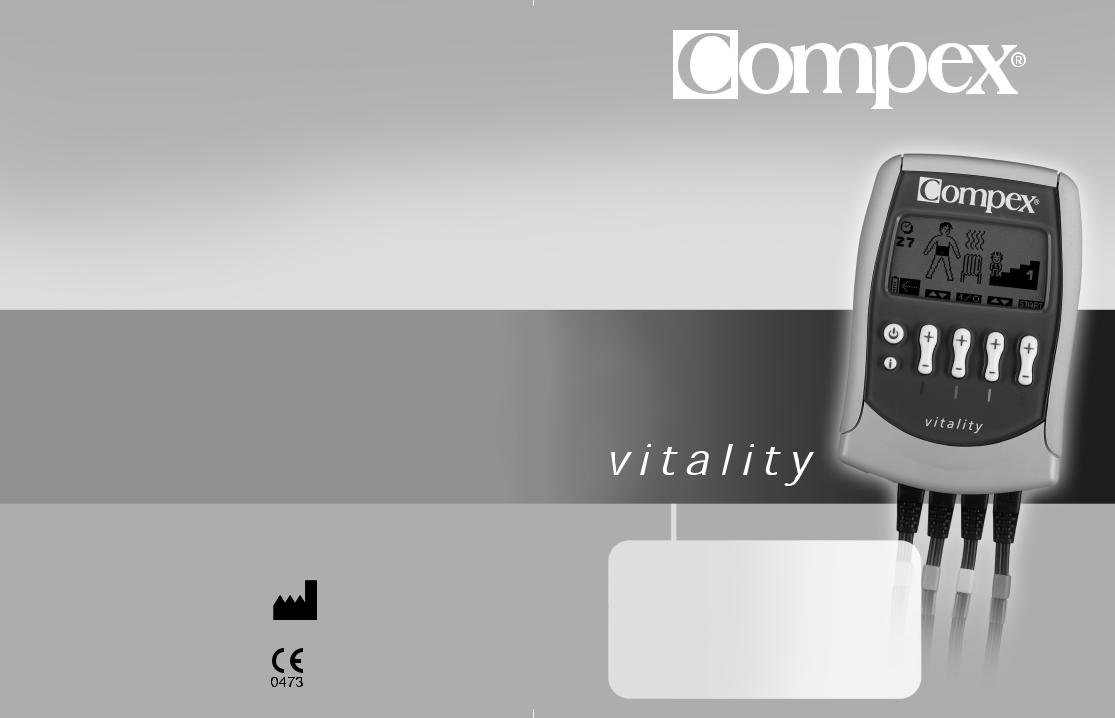
DJO France S.A.S. Centre Européen de Frêt 3 rue de Bethar
64990 Mouguerre, France © 12/2011 DJO, LLC
Compex® is a registered trademark of DJO, LLC
Art no. 885516 v8
User and applications manual Manuale d’uso e di applicazioni Manuel d’utilisation et d’applications
Gebrauchsund Anwendungshandbuch Gebruiksaanwijzing en specifieke toepassingen Manual de utilización y aplicaciones

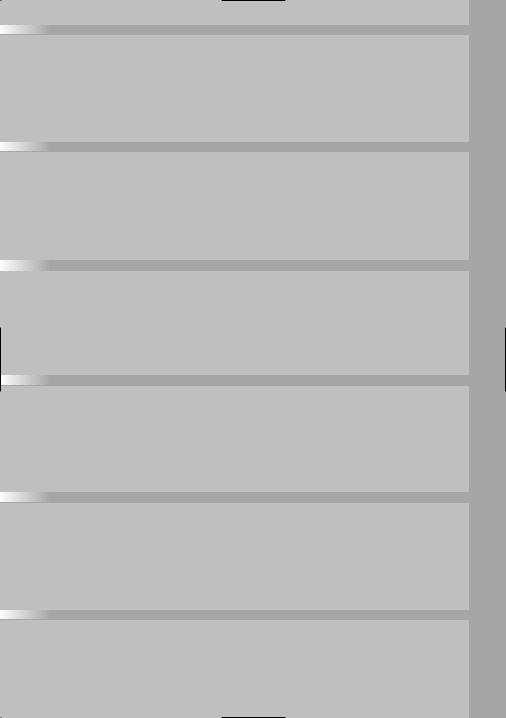
English
Directions for use |
11 |
Programs and specific applications |
20 |
Table with placements of electrodes and |
|
stimulation positions |
49 |
Italiano
Istruzioni per l’uso |
61 |
Programmi e applicazioni specifiche |
70 |
Tabella di posizionamento degli elettrodi |
|
e posizioni del corpo |
99 |
Français
Mode d’emploi |
111 |
Programmes et applications spécifiques |
120 |
Tableau de placements des électrodes |
|
et positions du corps |
149 |
Deutsch
Gebrauchsanweisung |
161 |
Programme und spezifische Anwendungen |
170 |
Tabelle zur Elektrodenplatzierung und |
|
Körperposition für die Stimulation |
199 |
Nederlands
Gebruiksaanwijzing |
211 |
Programma’s en specifieke toepassingen |
220 |
Tabel voor de plaatsing van de elektroden |
|
en de stimulatieposities |
249 |
Español
Modo de empleo |
261 |
|
Programas y aplicaciones específicas |
270 |
|
Tabla de colocación de los electrodos y |
|
|
de posición del cuerpo para la estimulación |
299 |
3 |

English
TABLE OF CONTENT
I. WARNINGS |
5 |
|
||
1. |
Counter-indications |
5 |
||
|
2. |
Safety measures |
5 |
|
|
|
|
|
|
II. PRESENTATION |
7 |
|
||
1. |
Reception of equipment and accessories |
7 |
||
|
2. |
Presentation of the device |
8 |
|
|
3. |
Guarantee |
8 |
|
|
4. |
Maintenance |
9 |
|
|
5. |
Storage and transportation conditions |
9 |
|
|
6. |
Use conditions |
9 |
|
|
7. |
Elimination |
9 |
|
|
8. |
Standards |
9 |
|
|
9. |
Patent |
10 |
|
|
10. Normalised symbols |
10 |
|
|
|
11. Technical information |
10 |
||
III. DIRECTIONS FOR USE |
11 |
|||
1. |
Connections |
11 |
||
|
2. Preliminary settings: language, light intensity and sound volume |
11 |
||
3. |
Selecting a program category |
12 |
|
|
|
4. |
Selecting a program |
12 |
|
|
5. |
Personalising a program |
13 |
|
|
6. |
During the stimulation session |
14 |
|
|
7. |
Electricity consumption and recharging |
15 |
|
|
8. |
Problems and solutions |
16 |
|
IV. HOW DOES ELECTROSTIMULATION WORK? |
17 |
|||
V. USE PRINCIPLES |
18 |
|
||
1. |
Placement of electrodes |
18 |
||
|
2. |
Stimulation position |
19 |
|
|
3. |
Setting the stimulation energy level |
19 |
|
|
4. |
Progression in the levels |
19 |
|
VI. PROGRAMS AND SPECIFIC APPLICATIONS |
20 |
|||
|
Pain relief category |
21 |
||
|
Massage category |
28 |
||
|
Vascular category |
31 |
||
|
Rehabilitation category |
35 |
||
|
Aesthetic category |
39 |
|
|
|
Fitness category |
44 |
|
|
VII. TABLE WITH PLACEMENTS OF ELECTRODES |
|
|
||
AND STIMULATION POSITIONS |
49 |
|||
4
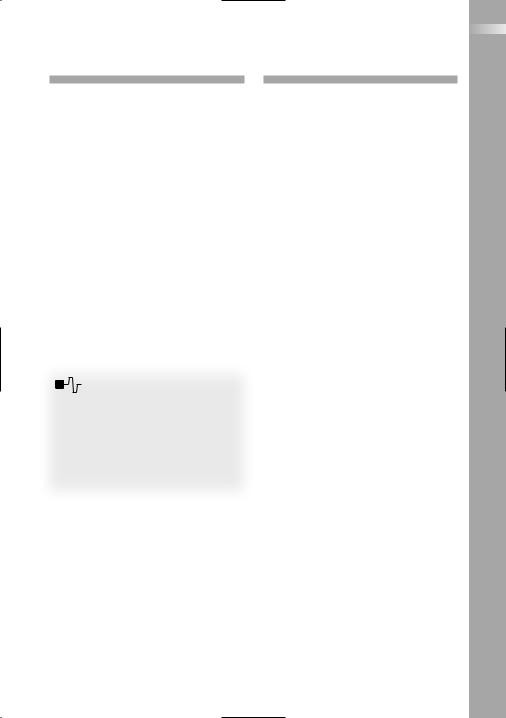
I.WARNINGS
1.Counter-indications
Important counter-indications
■Cardiac stimulator (pacemaker)
■Epilepsy
■Pregnancy (no positioning in the abdominal area)
■Serious arterial circulatory problems in the lower limbs
■Abdominal or inguinal hernia
Precautions when using the Compex
■After trauma or a recent operation (less than 6 months)
■Muscular atrophy
■Persistent pains
■Need for muscular rehabilitation
Osteosynthesis equipment
The presence of osteosynthesis equipment (metallic equipment in
contact with the bone: pins, screws, plates, prostheses, etc.) is not a contraindication for the use of Compex programs. The electrical current of the Compex is specially designed to have no harmful effect with regard to osteosynthesis equipment.
In all of the above cases, you are advised to:
■never use the Compex for prolonged periods without medical advice;
■consult your doctor if you are in any doubt whatsoever;
■read this manual carefully, in particular chapter VI, which provides information concerning the effects and indications of each stimulation program.
2. Safety measures
What you should not do with the Compex
■Do not use the Compex in water or in a humid atmosphere (sauna, hydrotherapy, etc.).
■Never carry out an initial stimulation session on a person who is standing. The first five minutes of stimulation must always be performed on a person who is sitting or lying down. In rare instances, very highly strung people may have a vagal reaction. This is of psychological origin and is connected with a fear of the muscle stimulation as well as surprise at seeing one of their muscles contract without having intentionally contracted it themselves. This vagal reaction produces a feeling of weakness with a fainting tendency, slowing down of the heartrate and a reduction in arterial blood pressure. If this does occur, all that is required is to stop the stimulation and lie down with the legs raised for the time it takes for the feeling of weakness to disappear (5 to 10 minutes).
■Never allow movement resulting from muscular contraction during a stimulation session. You should always stimulate isometrically; this means that the extremities of the limb in which a muscle is being stimulated must be firmly fixed, so as to prevent the movement that results from contraction.
■Do not use the device at less than 1.5 metres from a short-wave device, a micro-wave device or high frequency (H.F.) surgical equipment to avoid the risk of causing skin irritations or burns under the electrodes. If you are in any doubt about using the Compex in close proximity to any
English
5

English
6
other medical device, please consult its manufacturer or your doctor.
■Only use the electrode cables supplied by Compex.
■Do not disconnect the stimulator electrode cables during the session without first switching off the stimulator.
■Never connect stimulation cables to an external electric power supply because of risk of electric shock.
■No not use rechargeable batteries other than the one supplied by Compex.
■Never recharge the stimulator when cables and electrodes are still connected onto the user.
■Never recharge the batteries with another charger than the one supplied with the Compex.
■Never use the Compex or the charger if it is damaged (case, cables, etc.) or if the compartment for the rechargeable battery is open. There is a risk of electric discharge.
■Disconnect immediately the charger if the Compex “bleeps” continuously, in case of abnormal heating or smell, or if smoke comes from the charger or the Compex. Do not recharge the batteries in a confined area (case, etc.) because of risk of fire or electric discharge.
■Keep the Compex and its accessories out of the reach of children.
■Do not allow any foreign items (soil, water, metal, etc.) to enter into the Compex, the compartment for the rechargeable battery and the charger.
■Sudden temperature variations can create droplets in the device due to condensation. Use the device only once it reached ambient temperature.
■Do not use the Compex while driving or operating machinery.
■Do not use the stimulator in the mountains at an altitude higher than 3.000 metres.
Where you should never apply electrodes…
■To the head.
■Counter-laterally: Do not use the two poles of the same channel (one electrode connected to the positive/red pole and one electrode connected to the negative/black
pole) on either side of the body centreline (eg: right arm and left arm).
■To or in the vicinity of skin lesions of any kind (wounds, inflammations, burns, irritations, eczema, etc.).
Precautions when using the electrodes
■Only use the electrodes supplied by Compex. Other electrodes may have electrical properties that are unsuitable for the Compex stimulator.
■Do not remove or move the electrodes during a stimulation session without first switching off the instrument.
■Do not plunge the electrodes into water.
■Do not apply a solvent of any kind to the electrodes.
■Before applying the electrodes, it is recommended to wash and degrease the skin, and then dry it.
■Apply the whole surface of the electrodes to the skin.
■For very important reasons of hygiene, each user must have his own electrode set. Do not use the same electrodes on different people.
■Do not use a set of electrodes for more than fifteen sessions, as the quality of the contact between the electrode and the skin, which is important for the comfort and effectiveness of stimulation, progressively degrades.
■In certain people with very sensitive skin, redness may be observed under the electrodes after a

stimulation session. Generally, this redness is completely harmless and disappears after 10 to 20 minutes.
However, avoid starting a stimulation session on the same area until the redness is no longer evident.
II. PRESENTATION
1. Reception of equipment and accessories
Your stimulator is supplied with:
–The stimulator
–A battery charger
–One set of electrode cables with colour indicators (blue, green, yellow, red)
–Bags containing the electrodes (small (5 x 5 cm) and large (5 x 10 cm) electrodes)
–A user and applications manual
–A poster with the pictures for the placements of electrodes and the stimulation positions
–A belt clip
English
7
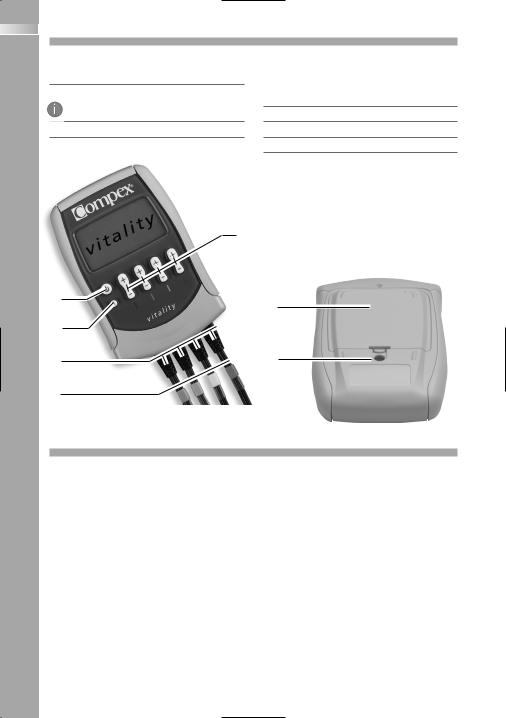
English
2. Presentation of the device
A– “On/Off” switch
B– “i” button. To increase the energy level
of several channels simultaneously
C – Sockets for the 4 electrode cables
E
D – Electrode cables |
|
|
|
channel 1 |
= blue |
channel 2 |
= green |
channel 3 |
= yellow |
channel 4 |
= red |
E– “+”/“–” keys of the 4 stimulation channels
F– Compartment for the rechargeable battery
G– Belt clip socket
A |
|
F |
|
|
|
B |
|
|
C |
|
G |
|
4 |
|
|
|
|
|
|
3 |
D |
1 |
2 |
|
|
3. Guarantee
Refer to the flyer attached.
8

4. Maintenance
To clean your unit, use a soft duster and an alcohol-based cleaning product, which does not contain any solvents. The user must not attempt any repairs to the device or any of its accessories. Never dismantle the Compex or the charger containing high-voltage parts because of risk of electric discharge. Compex Médical SA declines all responsibility for damages and consequences resulting from any attempt to open, modify or repair
the device or any of its components by a person or a service centre not officially approved by Compex Médical SA.
Compex stimulators do not require calibration or verification of performance parameters. The characteristics are systematically verified and validated for each device manufactured. These characteristics are stable and do not vary when used under normal conditions.
If your device seems to not function as expected, regardless of the situation, contact an official Compex service centre for assistance.
Medical and health professionals must refer to local legislation for information related to maintenance. Normally, these laws require verification of certain criteria at regular intervals.
5. Storage and transportation conditions
The Compex contains rechargeable batteries and so the storage and transportation conditions must not exceed the following figures:
Storage and transportation temperature: from -20°C to 45°
Max. relative humidity: 75%
Atmospheric pressure: from 700 hPa to 1060 hPa
6. Use conditions |
|
English |
|
|
|
Temperature of use: from 0°C to 40°C |
|
|
Max. relative humidity: from 30% to 75% |
|
|
Atmospheric pressure: from 700 hPa to1060 hPa |
|
|
Do not use in an explosion risk area. |
|
|
7. Elimination |
|
|
The Directive 2002/96/CEE (WEEE) |
|
|
has a first priority, the prevention of |
|
|
waste electrical and electronic equip- |
|
|
ment, and in addition, the re-use, |
|
|
recycling and other forms of recovery |
|
|
of such wastes so as to reduce the |
|
|
disposal of waste. |
|
|
The pictogram wheeled bin barred |
|
|
means that the equipment can not be |
|
|
thrown with the household refuse, |
|
|
but that it makes the object of a |
|
|
selective collection. |
|
|
The equipment has to be given to a |
|
|
suitable collection point for the |
|
|
treatment. |
|
|
By this way, you contribute to the |
|
|
safeguarding of the natural resources |
|
|
and the human health protection. |
|
|
Batteries must be disposed of in |
|
|
accordance with your country’s |
|
|
national laws governing the disposal |
|
|
of such items. |
|
|
8. Standards |
|
|
The Compex is based directly on |
|
|
medical technology. |
|
|
To guarantee your safety, the design, |
|
|
manufacturing and distribution of |
|
|
Compex are in conformity with the |
|
|
requirements of the European |
|
|
Directive 93/42/CEE. |
|
|
The device is in conformity with the |
|
|
standard for general safety rules for |
|
|
electromedical devices IEC 60601-1, |
|
|
the standard for electromagnetic |
|
|
compatibility IEC 60601-1-2 and the |
|
|
standard for special safety rules for |
9 |
|
|
|
|
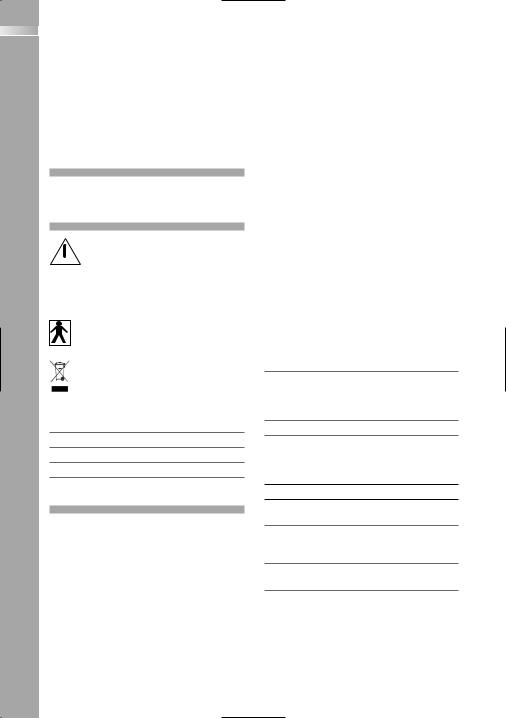
English
nerve and muscle stimulators IEC 60601-2-10.
Current international standards (IEC 60601-2-10 AM1 2001) require that a warning be given concerning the application of electrodes to the thorax (increased risk of cardiac fibrillation). Directive 2002/96/CEE Waste electrical and electronic equipment (WEEE).
9. Patent
Snap electrode: patent pending.
10. Normalised symbols
Important: Under some
 conditions, the effective figure for the stimulation pulses can exceed 10 mA and 10 V. The information given in this handbook must be strictly observed.
conditions, the effective figure for the stimulation pulses can exceed 10 mA and 10 V. The information given in this handbook must be strictly observed.
The Compex is a class II device unit with its own internal electric
power, with type BF applied sections. Waste electrical and electronic equipment (WEEE).
The “On/Off” switch is a  multi-function key:
multi-function key:
Functions |
Symbol N°(according to CEI 878) |
|
On/Off (2 positions, stable) |
01-03 |
|
Waiting or preparation for part of the unit 01-06
Stop (switching off) |
01-10 |
11. Technical information
General points
Power supply: NIMH rechargeable battery (NIMH) (4,8 V ª 1200 mA/h). Chargers: The only chargers used for recharging the battery bear the following information:
EUROPE |
Type TR503-02-E-133A03 |
|
|
Input 90-264 VAC / 47-63Hz / 0.5A max. |
|
|
Output 9V / 400mA / 6W |
|
|
Type TR1509-06-E-133A03 |
|
|
Input 90-264 VAC / 47-63Hz / 0.5A max. |
|
|
Output 9V / 1.4A / 15W |
|
USA |
|
|
Type TR503-02-E-133A03 |
||
|
Input 90-264 VAC / 47-63Hz / 0.5A max. |
|
|
Output 9V / 400mA / 6W |
|
|
Type TR1509-06-E-133A03 |
|
|
Input 90-264 VAC / 47-63Hz / 0.5A max. |
|
UK |
Output 9V / 1.4A / 15W |
|
|
||
Type TR503-02-E-133A03 |
||
|
||
|
Input 90-264 VAC / 47-63Hz / 0.5A max. |
|
|
Output 9V / 400mA / 6W |
|
|
Type TR1509-06-E-133A03 |
|
|
Input 90-264 VAC / 47-63Hz / 0.5A max. |
|
|
Output 9V / 1.4A / 15W |
Neurostimulation
All electrical specifications are given for a charge between 500 and 1000 ohms per channel.
Channels: four independent and individually adjustable channels electrically insulated from each other and from ground
Impulse shape: constant rectangular current compensated to eliminate any direct current component to avoid any residual skin polarisation
Maximum current of an impulse: 80 milliamperes
Intensity increase interval:
–Manual stimulation intensity adjustment: 0-444 (energy units)
–Impulse duration: 0.5 mA
Impulse duration: from 50 to 400 microseconds
Maximum quantity of electricity per impulse: 80 microcoulombs (2 x 40 µC compensated)
Typical rise time for an impulse:
3 microseconds (between 20% and 80% of maximum current)
Impulse frequency: from 1 to 150 Hertz
10
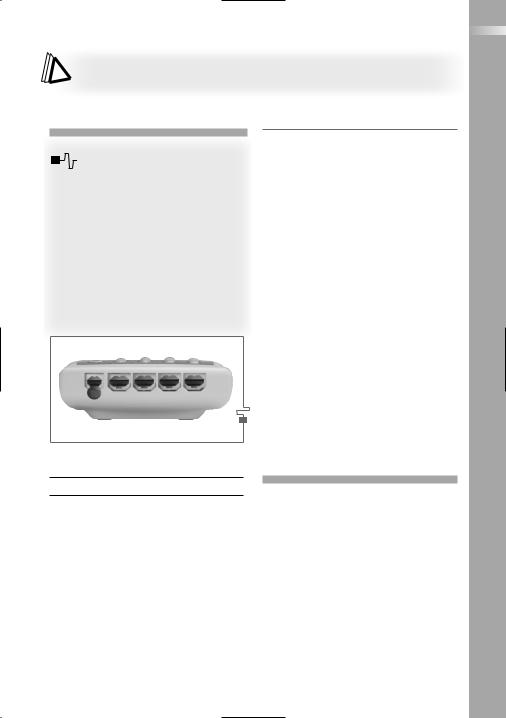
III. DIRECTIONS FOR USE
Before using the unit for the first time, you are strongly advised to take careful note of  the counter-indications and safety measures detailed at the beginning of this manual
the counter-indications and safety measures detailed at the beginning of this manual
(chapter I: “Warnings”), as this powerful equipment is neither a toy nor a gadget!
1. Connections
The electrical impulses generated by the Compex are transmitted to the
nerves by self-adhesive electrodes. The choice of the size, the connection and the correct positioning of the electrodes are essential factors for ensuring effective and comfortable stimulation. So they require particular care. To do all this – and for information on the recommended stimulation positions – refer to the pictures and pictograms in the poster, and to the “Table with placements of electrodes and stimulation positions” in chapter VII. The specific applications contained in chapter VI also provide useful relevant information.
1b
1a 1a 1a 1a
blue = channel 1 |
yellow = channel 3 |
green = channel 2 |
red = channel 4 |
It is important to place the electrodes correctly to the cable connectors; in order to do so, press strongly the connector to the electrode until you hear a double click.
Connecting the charger
The Compex has considerable operating autonomy, as it uses rechargeable batteries. To recharge them, use the charger supplied with your device and connect it to the base of the device, then plug the charger in a socket.
To recharge the Compex, first disconnect the electrode cables from the device.
Before using your stimulator for the first time, it is always strongly recommended that you completely charge the battery to improve its autonomy and extend its working life.
English
Fig. 1 – Base of device
1a Sockets for the four electrode cables
1b Socket for the battery charger
Connecting the electrodes and cables
The electrode cables are connected to the stimulator through sockets on the base of the device.
Four cables can be connected simultaneously to the four channels of the device.
For easier use and better identification of the four channels, we advise you to follow the colour of the electrode cables and the stimulator sockets:
2. Preliminary settings: language, light intensity and sound volume
Before using the unit for the first |
|
time, you should select the working |
|
language of the device which is |
|
displayed on the options screen. |
|
Proceed as per the instructions |
|
described below. |
|
Afterwards, for the greatest comfort, |
|
Compex offers you a number of |
|
setting options (operating language |
|
selection, display contrast setting |
|
and sound volume setting). |
|
To do this, display the options |
|
screen by pressing the “On/Off” |
|
switch on the left of the Compex |
11 |
and hold it down for a few seconds. |
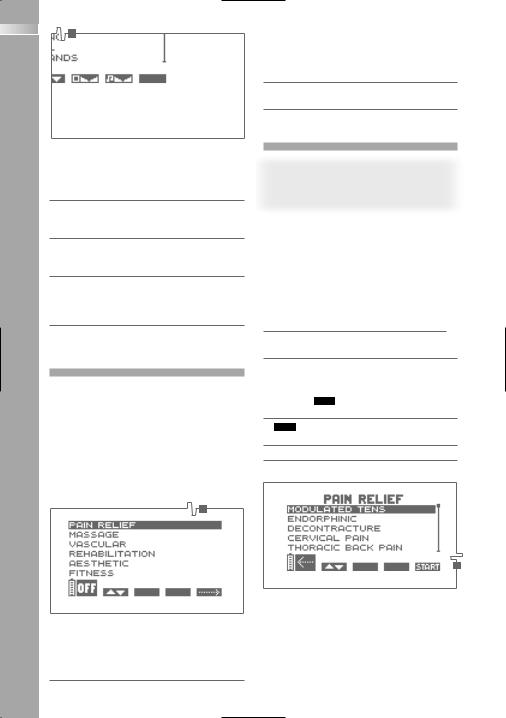
English
2d |
2a |
2b |
2c |
Fig. 2
2a To select the language of your choice, press the “+”/“–” key of channel 1 (to go up or down), until the desired language is displayed in white characters on a black background.
2b To set the contrast of the display, press the “+”/“–” key of channel 2 (“+” to increase the preferred percentage and “–” to reduce it).
2c To set the sound volume, press the “+”/“–” of channel 3 (“+” to increase the preferred percentage and “–” to reduce it).
2d To confirm the parameters selected, press the “On/Off” switch. Your stimulator saves your options. It is now ready for use with the settings you selected.
3. Selecting a program category
To switch on your stimulator, briefly press the “On/Off” switch on the left of the Compex. A musical signal can be heard and a screen showing the different program categories is displayed.
Before choosing a program, you should select the desired category.
3c |
3a |
3b |
|
|
Fig. 3
3a To select the desired category, press the “+”/“–” key of channel 1 (to go to the left) or channel 3 (to go to the right), until the desired category is displayed in a frame.
3b To confirm your choice and to move on to the program selection screen (see the next section: “Selecting a program”), press the “+”/“–” key of channel 4.
3c Press the “On/Off” key to switch off the stimulator.
4. Selecting a program
 To choose a program, it is particularly useful to consult chapter VI of this
To choose a program, it is particularly useful to consult chapter VI of this
manual (“Programs and specific applications”).
Regardless of the category you selected in the previous step, a list containing a select number of programs appears on the screen.
4a To select the desired program, press the “+”/“–” key of channel 1 (to go up or down), until the desired program is displayed in white characters on a black background.
4b Press the “On/Off” key to return to the previous screen.
4c After selecting the desired program, press the “+”/“–” key of channel 4 which, depending on the program selected, displays the symbol START or .
a) START = the stimulation session starts immediately;
b)= a parameter setting screen displays.
4b
Fig. 4 |
4a |
4c |
12
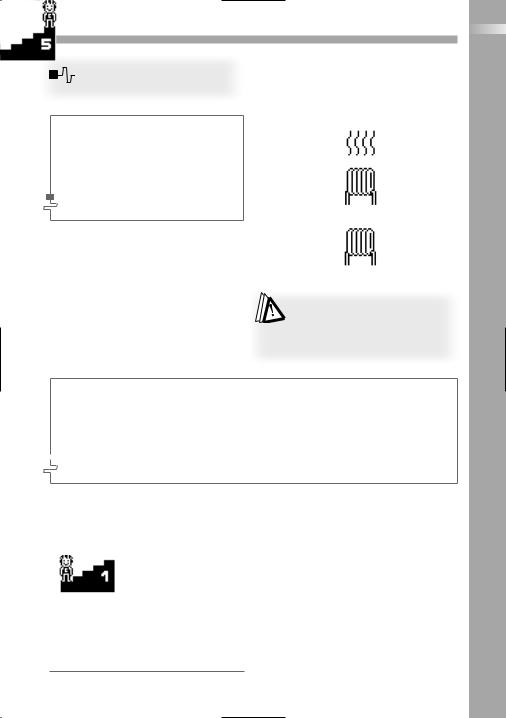
5. Personalising a program
The program personalisation screen is not available for all programs.
5d
5e
Fig. 5 5a 5b 5c 5f
5a Certain programs require manual selection of the muscular group that you want to stimulate and a figurine is displayed above
channel 1.
To select your desired group, press the “+”/“–” key of channel 1 (to go up or down). The seven muscular groups are displayed in succession in black on the figurine:
5b The warming-up sequence suggested for some programs is active by default (an animated rising convection symbol above the heater). If you prefer to skip this sequence, press the “+”/“–” key of channel 2.
Warming-up
No warming-up
Current international standards require that a warning be given concerning the application of
electrodes to the thorax (increased risk of cardiac fibrillation).
Abdomen and Lower back |
Thighs |
Forearms and Hands |
Thorax and Back |
|
|
vb |
c |
m |
td |
|
f |
j |
e |
|
|
|
|||
|
|
|||
|
Buttocks |
Legs and Feet |
Shoulders and Arms |
|
5c Certain programs allow you to adjust the level of work. To do this, press the “+”/“–” key of channel 3 (to go up or down), until the desired level of work is displayed.
Level 1 |
Level 2 |
Level 3 |
Level 4 |
Level 5 |
||
5d Total program time in minutes. |
|
|
5f To confirm your selection and start the |
|||
|
|
|
|
program, press the “+”/“–” key of channel 4. |
||
5e By pressing the “On/Off” key, you can |
|
|||||
return to the previous screen.
English
13
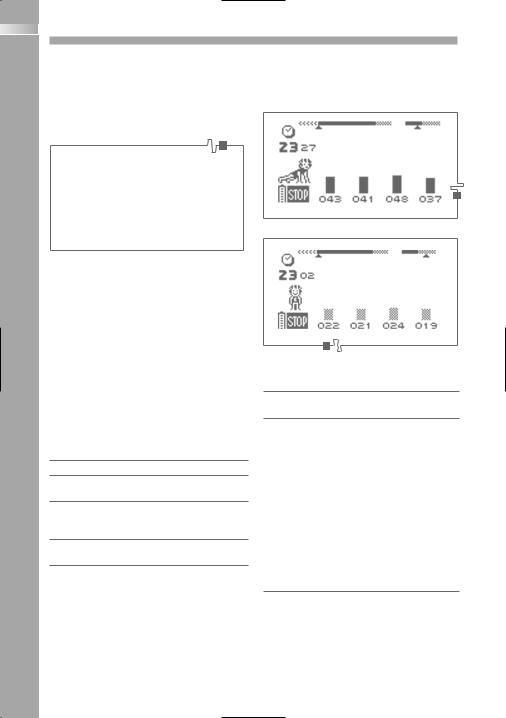
English
6. During the stimulation session
Setting stimulation energy
When the program starts, the Compex prompts you to increase the stimulation energy, a key factor for the effectiveness of the stimulation.
6d
6b
6a
6c
6e
below are sufficient for you to understand the general rules.
7c 7d
7a
7e
7b
7f
Fig. 7
Fig. 6
6a The Compex “bleeps” and the symbols of the four channels flash, changing from “+” to “000”: the four channels are at 0 energy. You must increase the stimulation energy so that the stimulation can start. To do this, press the “+” of the keys of the relevant channels, until the desired setting is reached.
If you want to increase the energy level of all four channels simultaneously, press the “i” button, located below the “On/Off” key. You can also increase the energy level of three first channels, by pressing the “i” button twice, or the energy level of two first channels only, by pressing three times this button.
Once you activate the “i” button, the associated channels are highlighted in white on a black background.
6b Remaining time in minutes and seconds.
6c The animated rising convection symbol represented the warming-up sequence.
6d Session progression scale. For details on how it works, see the following section (“Program progression”).
6e By pressing the “On/Off” key, you can return to the previous screen.
Program progression
Stimulation does really start when the stimulation energy has been increased. The screens that are displayed during stimulation allow you to observe the progression of the session. These screens may differ from one program
14 to another. The examples reproduced
8a |
8c |
8d |
|
|
8e
8b
8f
Fig. 8
7a-8a Remaining time (in minutes and seconds) before the end of the program.
7b-8b A small animated symbol indicating category to which the program belongs.
7c-8c Session progression scale:
The progression scale is composed of three distinct parts: the program consists of three stimulation sequences, i.e., warming up (light hatching /left), the actual work (black area/centre) and relaxation at the end of the program (heavier hatching/right).
The progression scale can be also entirely hatched: the program then consists of a single stimulation sequence.
The small cursor located just below the scale moves horizontally and indicates precisely the state of progression of the program (here: start of the first sequence, i.e., the work sequence).
7d-8d Contraction and active rest time bar: This bar is displayed at the right of the progression scale, but only during the work sequence. It indicates the duration of the contraction and active rest times.
7d The cursor is located under the black (left) part of the bar: you are in a muscular contraction phase.
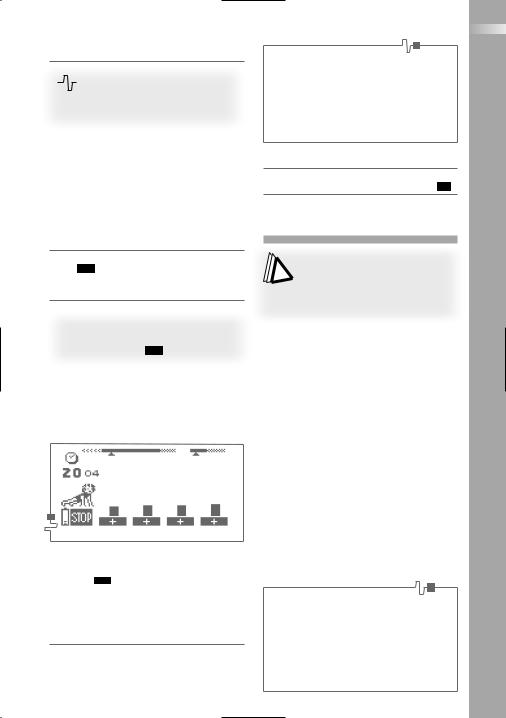
8d The cursor is located under the hatched (right) part of the bar: you are in an active rest phase.
 The stimulation energy during the active rest phase is automatically set at 50% of the stimulation energy during
The stimulation energy during the active rest phase is automatically set at 50% of the stimulation energy during
the muscular contraction.
7e-8e Bar charts:
7e The muscular contraction phase is represented by the bar charts of the stimulation channels used (which become black during the contraction phase).
8e The active rest phase is represented by the bar charts of the stimulation channels used (which become hatched during the active rest phase).
7f-8f You can interrupt the program momentarily ( STOP = “PAUSE”) ”) by pressing the “On/Off” key. If you wish to restart the session, simply press the “+”/“–” key of channel 4.
 After an interruption, stimulation restarts at 80% of the stimulation
After an interruption, stimulation restarts at 80% of the stimulation
energy set before the STOP .
Adjusting stimulation energy
9a
Fig. 9
9a During the session, the Compex “bleeps” and some + symbols start to flash above the active channels (over the energy indications): the Compex is prompting you to increase the stimulation energy level. If you cannot support an increase of the energy, just ignore this message.
End of program
10a
10b
Fig. 10
10a At the end of the session, you hear a musical signal and a small flag is displayed.
10b It is then only necessary to switch off the stimulator by pressing the “On/Off” key ( OFF ).
7. Electricity consumption and recharging
Never recharge the stimulator with  cables still connected to it.
cables still connected to it.
Never recharge the batteries with a charger different from the one supplied by Compex.
The Compex runs on rechargeable batteries. The discharge time depends on the programs and stimulation energy used.
Before using your stimulator for the first time, it is always strongly recommended that you completely charge the battery to improve its autonomy and extend its working life. If you do not use your device for a
long period of time, please regularly recharge the battery.
Electricity consumption
The symbol of a small battery indicates the charge level of the batteries.
11a
11b
English
Fig. 11 |
15 |
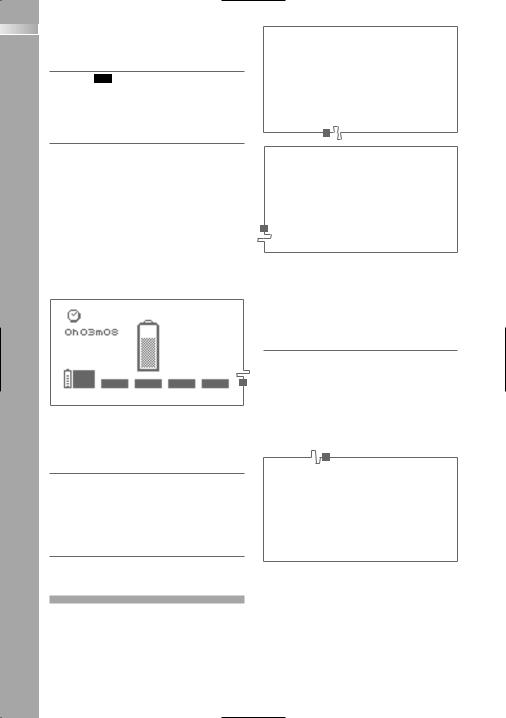
English
11a The small battery symbol has only two reference marks: The batteries are losing their charge. Interrupt the session and recharge the device (see the following section).
11b The START , symbol normally displayed above the “+”/“–” key of channel 4 has disappeared (  ) and the small battery flashes: The batteries are completely flat. It is no longer
) and the small battery flashes: The batteries are completely flat. It is no longer
possible to use the device. Recharge it Fig. 13 immediately (see the following section).
13a
Recharging
To recharge the Compex, first disconnect the electrode cables from the device, then plug the charger in a socket and lastly connect the stimulator to the charger (see in section I: “Connecting the charger”). The charge menu illustrated below appears automatically.
12a
12b
Fig. 12
12a The Compex has been charging for 3 minutes and 8 seconds (a full charge may take from 1h30 to 2 hours with the rapid charger delivered with your device).
12b Charging is in progress and the small battery symbol is not completely full. When charging is completed, total charge duration flashes and the small battery is completely full. The Compex switches off
automatically as soon as you disconnect the charger.
.
|
8. Problems and solutions |
|
Electrode fault |
|
13a-14a The Compex “bleeps” and alterna- |
|
tively displays the symbol of a couple of elec- |
|
trodes and an arrow pointing to the channel |
|
where a problem has been detected. Below, |
16 |
the stimulator has detected an electrode |
fault on channel 2. |
14a
Fig. 14
This message may mean that:
1)there is no electrode connected to this channel;
2)the electrodes are old, worn out and/or the contact is poor: try using new electrodes;
3)the electrode cable is defective: try it using another channel. If cable shows a default again, please replace.
Recharging error
A recharging error may happen during charging. The Compex “bleeps” continuously and the following screen is displayed:
Fig. 15
If this message appears, disconnect the charger and the device switches off automatically. Please contact the hotline, noting this error code.
If, for any reason, you experience any other trouble with your device, please contact the hotline mentioned and approved by Compex Médical SA.
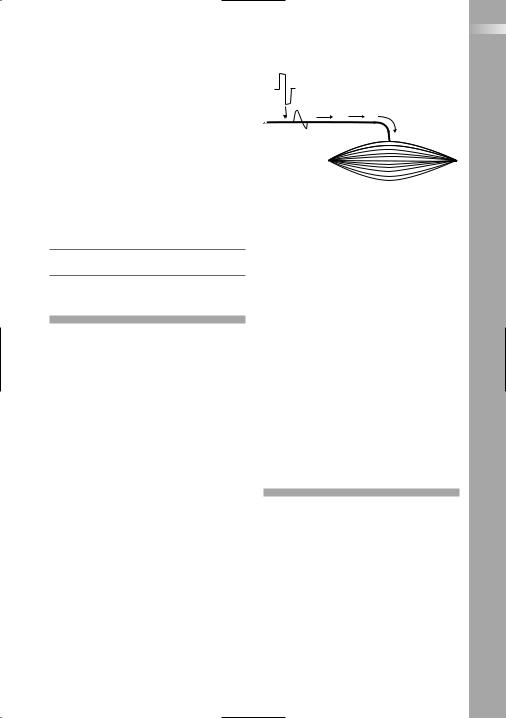
IV. HOW DOES ELECTROSTIMULATION WORK?
The principle of electrostimulation is to stimulate nerve fibres by means of electrical impulses transmitted by electrodes.
The electrical impulses generated by Compex stimulators are high-quality impulses – ensuring safety, comfort and efficiency – that stimulate different types of nerve fibres:
1.the motor nerves to stimulate a muscular response. The quantity of work and the benefits obtained depend on the stimulation parameters. This is known as electromuscularstimulation (EMS).
2.certain types of sensitive nerve fibres to obtain analgesic or pain-relieving effects.
1. Motor nerve stimulation (EMS)
In voluntary activity, the order for muscular work comes from the brain, which sends a command to the nerve fibres in the form of an electrical signal. This signal is then transmitted to the muscular fibres, which contract. The principle of electrostimulation accurately reproduces the process observed during a voluntary contraction. The stimulator sends an electrical current impulse to the nerve fibres, exciting them. This excitation is then transmitted to the muscular fibres causing a basic mechanical response (= muscular twitch). The latter constitutes the basic requirement
for muscular contraction.
This muscular response is completely identical to muscular work controlled by the brain. In other words, the muscle cannot distinguish whether the command comes from the brain or from the stimulator.
The parameters of the Compex programs (number of impulses per second, contraction time, rest time, total program time) subject the
Electrical impulse
Excitation
Excitation
transmission
Motor nerve
Stimulated muscle
Basic mechanical response = muscular twitch
muscles to different types of work, according to muscular fibres. In fact, different types of muscular fibres may be distinguished according to their respective contraction speed: slow, intermediate and fast fibres. The fast fibres will obviously predominate in a sprinter, while a marathon runner will have more slow fibres.
With a good knowledge of human physiology and a perfect mastery of the stimulation parameters of the various programs, the muscular work can be directed very precisely towards the desired goal (muscular reinforcement, increased blood flow, firming up, etc.).
2. Stimulation of the sensitive nerves
The electrical impulses can also excite the sensitive nerve fibres to obtain an analgesic or pain-relieving effect.
The stimulation of the tactile sensitive nerve fibres blocks the transmission of pain by the nervous system.
The stimulation of another type of sensitive fibres creates an increase in the production of endorphins and, therefore, a reduction of pain.
With pain relief programs, electrostimulation can be used to treat localized sharp or chronic pains as well as muscular pains.
English
17

English
Do not use the pain relief programs for a long period without medical advice.
 Benefits of electrostimulation
Benefits of electrostimulation
Electrostimulation is a very effective way to make your muscles work:
■with significant improvement of different muscular qualities,
■without cardio-vascular or mental fatigue,
■with limited stress on the joints and tendons.
Electrostimulation thus allows a greater quantity of work by the muscles compared with voluntary activity.
To be effective, this work must involve the greatest possible number of muscular fibres. The number of fibres working depends on the stimulation
energy. It will therefore be necessary to use the maximum tolerable energy. The user controls this aspect of stimulation. The higher the stimulation energy, the greater the number of muscular fibres that are working and, therefore, the more significant the progress achieved.
To maximize your results, Compex recommends that you complement your electrostimulation sessions with other efforts, like:
■regular exercise,
■proper and healthy nutrition,
■balanced lifestyle.
V. USE PRINCIPLES
The use principles presented in this section should be considered general rules. For all programs, it is recommended that you read carefully the information and advice on use presented in chapter VI of this manual (“Programs and specific applications”).
1. Placement of electrodes
It is recommended that you comply with the suggested placements. To do
this, refer to the pictures and pictograms shown on the poster and to the “Table with placements of electrodes and stimulation positions” in chapter VII.
A stimulation cable consists of two poles:
a positive pole (+) = red connection
a negative pole (–) = black connection
A different electrode must be connected to each of the two poles.
Note: It is possible and normal to have an electrode arrangement that leads one electrode connection free from a cable.
Depending on the characteristics of the current used for each program, the electrode connected to the positive pole (red connection) is more effective when placed in a “strategic” position.
For all muscle electrostimulation programs, i.e., programs involving muscle contractions, it is important to place the positive polarity electrode on the muscle motor point.
18
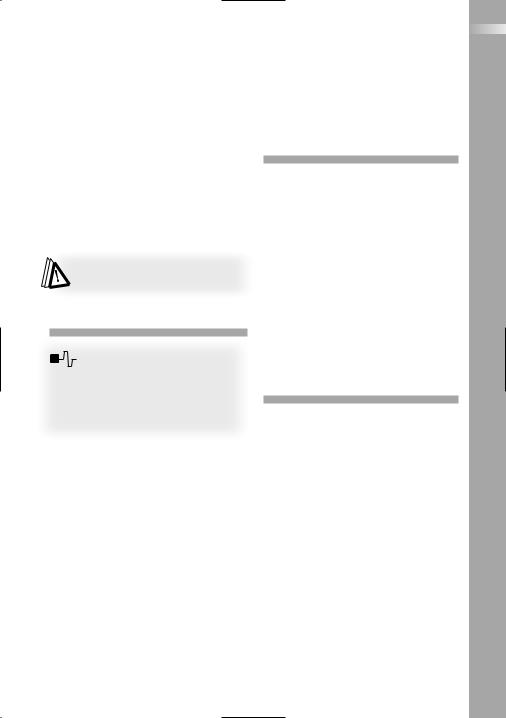
The choice of electrodes size (large or small) and the correct positioning of the electrodes on the muscular group to be stimulated are determinant and essential factors for the effectiveness of the stimulation. Therefore, always use the size of electrodes shown in the pictures. Unless you have other specific medical instructions, always follow the placement directions in the pictures. If necessary, find the best position by slightly moving the positive polarity electrode, so as to obtain the best muscle contraction
or the position that seems most comfortable.
Compex Group disclaims all responsibility for electrodes positioned in any other manner.
2. Stimulation positions
To determine the stimulation position to adopt depending on the placement
of the electrodes and the chosen program, refer to the pictures and pictograms on the poster and to the “Table with placements of electrodes and stimulation positions” in chapter VII.
The stimulation position depends on the muscular group to be stimulated and the program chosen.
For the programs involving powerful muscular contractions, the muscle should always be stimulated in an isometric fashion. Consequently, you should fix the extremity of the stimulated limb(s) firmly. In this way, you provide maximum resistance to the movement and prevent any shortening of the muscle during the contraction, which could create cramp pains and serious stiffness after the session. For example, when stimulating the quadriceps, the user should be in a seated position with the ankles fixed with straps to prevent extension of the knees.
For the other types of programs (for example, the Pain programs and the Active recovery program), which do not involve powerful muscular contractions, position yourself as comfortably as possible.
3. Setting the stimulation energy level
In a stimulated muscle, the number of recruited fibres depends on the stimulation energy. For the programs involving powerful muscular contractions, it is therefore absolutely necessary to use maximum stimulation energy, always at the limit of what you can support, so as to involve the greatest possible number of fibres. The “Table with placements of electrodes and stimulation positions” in chapter VII provides information on the energy to use, depending on the selected program.
4. Progression in the levels
In general, it is not advisable to go through the different levels quickly with the intention of reaching level 5 as fast as possible. In fact, the different levels correspond to progress with electrostimulation.
The simplest and most usual procedure is to start with level 1 and raise the level when changing to a new stimulation cycle.
At the end of a cycle, you may either start a new cycle at the next level up or do some maintenance at the rate of 1 session a week at the last level reached.
English
19
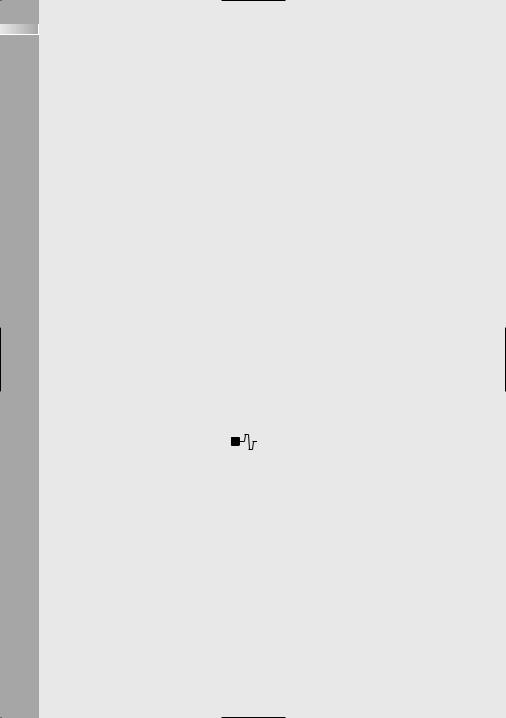
English
VI. PROGRAMS
AND SPECIFIC APPLICATIONS
The applications that follow are given by way of example. They provide a better understanding of how electrostimulation sessions can be combined with voluntary activity. These protocols will help you to determine the best procedure to follow depending on your needs (choice of the program, muscular group, duration, placement of the electrodes, body position).
You can of course choose a muscular group different from the one indicated, depending on the activities you practice or the body area you wish to stimulate.
The specific applications provide you information on the placement of electrodes and the stimulation position to adopt. This information is represented by numbers (placement of electrodes) and letters (stimulation position).
They refer to the “Table with placements of electrodes and stimulation positions” in chapter VII and to the
poster with the pictures for the placements of electrodes and the pictograms for the body positions. The table also indicates the stimulation energy to use, according to the program.
You must select in the device the muscular group indicated on the figurine. When no figurine appears (–), it is not necessary to choose the muscular group: the selection is automatic.
20
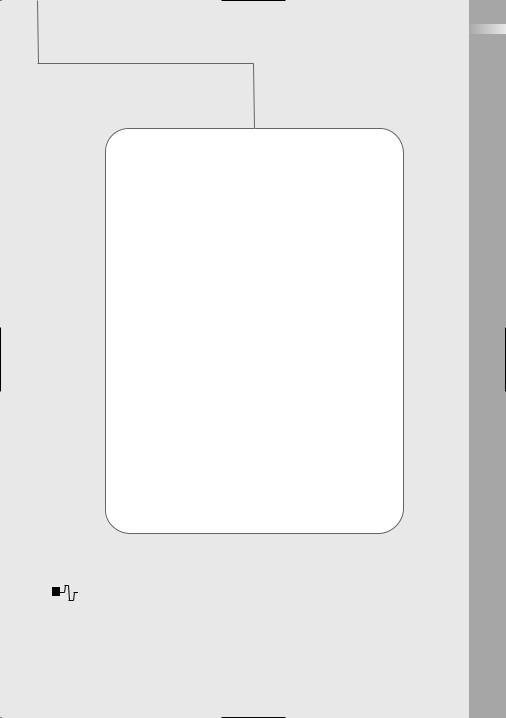
Pain relief category
Physical pain is an abnormal and unpleasant sensation caused by an injury, a disorder or incorrect functioning of a part of our organism. It is always a signal sent to us by our bodies, one that should not be ignored, and that in all cases requires us to consult a doctor if it does not disappear quickly.
The approach to pain adopted by the medical profession has changed considerably in recent years. Treatment of the cause is always fundamental, however the pain as such must be otherwise removed or at least considerably reduced and made bearable for the patient. The means to combat pain have developed greatly, and there is no longer any hesitation today in using powerful analgesics to improve the quality of life of patients. It is within this context that recourse to electrotherapy has developed. Excitation of the nerve fibres of sensation by means of electrical micro-impulses is often the preferred method of combatting pain. Today, such analgesic electrotherapy is widely used, particularly in rehabilitation medicine and in specialist pain treatment centres.
The precision of electrical currents allows the analgesic action to be accurately targeted according to the type of pain. It is up to the user to choose the most appropriate program for the type of pain and to follow practical recommendations in order to obtain maximum effect.
If the pain is great and/or persistent, you are advised to consult a doctor. Only a doctor can make an accurate diagnosis and put in place therapeutic actions designed to encourage disappearance of the disorder.
English
21
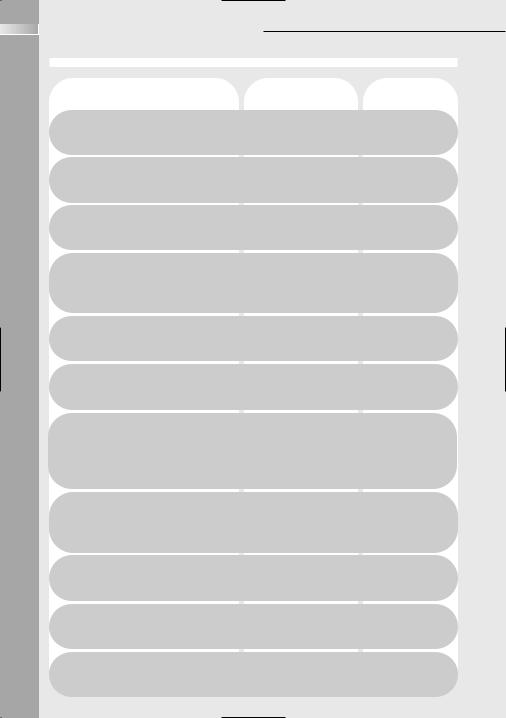
English
Pain relief
Table of the pathologies
Chronic muscular pain in
Muscular pain in the low |
Low back pain |
See application |
|
region (low back pain) |
page 25 |
||
|
22
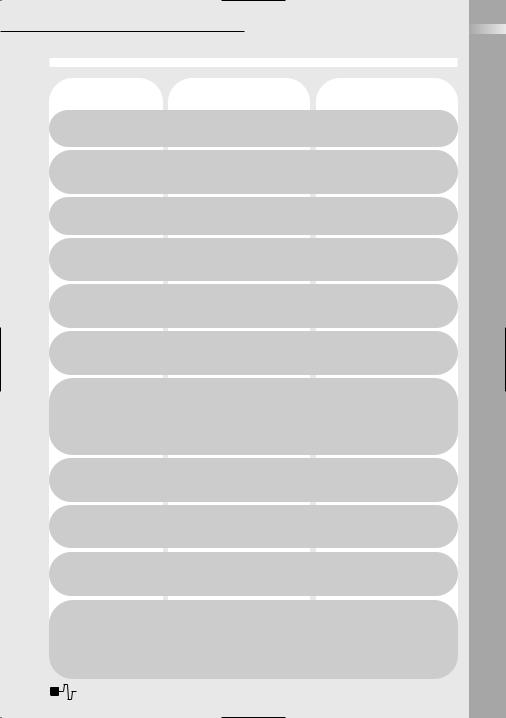
Pain relief
Analgesic action through
Cervical
Thoracic
Low
Lumbosciatica
Arthralgia
Analgesic action through
Analgesic action through
Analgesic action through
Analgesic action through the release of endorphinis Increased blood flow
Reduced muscular tension
Blocks transmission of pain
Reduced muscular tension
Blocks transmission of pain by the nervous system
Analgesic current specifically
Analgesic current specifically
Analgesic current specifically
Analgesic current specifically adapted to low back pain (lumbar region) combined with pain in the buttocks running
Analgesic current specifically
Analgesic current specifically
Analgesic current specifically
Analgesic current specifically adapted to persistent pain in a joint, as in osteoarthritis and rheumatsim (all joints in the limbs except the elbow: see the Epicondylitis program above)
English
23

English
Pain relief
Specific applications
Neuralgia of the upper limb (brachial neuralgia)
Some people suffer from arthritis in the joints of the vertebrae at the back of the neck, or from arthritis or periarthritis of the shoulder. These situations often give rise to pain that runs down one arm and is known as “brachial neuralgia”. These arm pains that start in the shoulder or the back of the neck can be reduced with the Compex Modulated TENS program by following the practical recommendations outlined below.
Cycle duration: 1 week, 1 x/day minimum, then adapt according to how the pain develops
According to requirements, the Modulated TENS program can be repeated a number of times during the same day
Program: Modulated TENS 35◊
Chronic muscular pain (polymyalgia)
Some people suffer from muscular pain that affects several muscles or parts of different muscles at the same time. The localization of this chronic pain can vary over time. These continual and diffuse muscle pains are the result of chronic contractures in which acids and toxins accumulate, irritating the nerves and causing pain. The Endorphinic program is particularly effective against such pain since, in addition to its pain-reducing effect, it increases the blood flow to the contractured muscular groups and removes from them accumulations of acids and toxins.
Example: localized pain in the biceps. However, the pain may affect other muscular groups. The practical application illustrated below remains valid, but it is then necessary to place the electrodes on the muscular group concerned.
Cycle duration: 4 weeks, 2 x/day, with a 10 minute break between the 2 sessions
You are advised to consult your doctor if no improvement is observed after the first week of use
Program: Endorphinic 20◊
Contracture (eg: localized contracture in external side of the calf)
After tiring muscle work, intense training or a sporting competition, certain muscles or certain parts of muscles often remain tense and slightly painful. These are known as muscular contractures which should disappear after a few days with rest, good rehydration, a balanced food intake with mineral salts and application of the Decontracture program. The phenomenon of contracture frequently affects the calf muscles, but can also occur with other muscles. In this case, simply follow the same practical recommendations as below, but place the electrodes on the muscular group concerned.
Cycle duration: 1 week, 1 x/day
You are advised to consult your doctor if no improvement is observed after the first week of use
Program: Decontracture 24◊
Chronic muscular pain in the back of the neck (cervical pain)
Positions in which the muscles of the back of the neck remain tense for long periods of time, for example working in front of a computer screen, may be responsible for the onset of pain in the back of the neck or on either side of the base of the neck, in the upper back. These pains are due to a contracture of the muscles, of which the prolonged tension crushes the blood vessels and prevents the blood from supplying and oxygenating the muscle fibres. If this phenomenon is prolonged, there is an accumulation of acid and the blood vessels atrophy. The pain then becomes continuous or appears after only a few
minutes spent working in an unfavourable position.
These chronic pains in the back of the neck can be treated effectively with the Cervical pain program, which reactivates the circulation, drains accumulations of acid, oxygenates the muscles, develops the capillaries and relaxes the contractured muscles.
24

Pain relief
Cycle duration: 4 weeks, 2 x/day, with a 10 minute break between the 2 sessions
You are advised to consult your doctor if no improvement is observed after the first week of use
Program: Cervical pain 15◊
Muscular pain in the thoracic region (thoracic back pain)
Vertebral arthritis and positions in which the muscles of the spinal column remain under tension for long periods of time are often responsible for the onset of pain in the middle of the back, which is accentuated with fatigue. Pressure of the fingers on the muscles on either side of the spinal column can often trigger a sharp pain. These pains are due to a contracture of the muscles, of which the prolonged tension crushes the blood vessels and prevents the blood from supplying and oxygenating the muscle fibres. If the phenomenon is prolonged, there is an accumulation of acid and the blood vessels atrophy. The pain then becomes continuous or can appear after only a few minutes spent working in an unfavourable position. These chronic back pains can be effectively treated with the Thoracic back pain program which reactivates the circulation, drains accumulations of acid, oxygenates the muscles, develops the capillaries and relaxes the contractured muscles.
Cycle duration: 4 weeks, 2 x/week with a 10 minute break between the 2 sessions
You are advised to consult your doctor if no improvement is observed after the first week of use
Program: Thoracic back pain 13◊
Muscular pain in the low back region (low back pain)
Low-back pain is the most frequently encountered pain. In a standing position, the entire weight of the trunk is concentrated on the joints between the last vertebrae and the sacrum. The low back region is therefore under particular strain. The discs between the vertebrae are crushed and the low back muscles contractured and painful.
There are very many treatments for the relief of low back pain sufferers; among
these, the specific currents of the Compex |
English |
Low back pain program provide an |
|
appreciable improvement and can even |
|
resolve the problem if it is essentially |
|
muscular in origin. |
|
Cycle duration: 4 weeks, 2 x/day, with a 10 minute break between the 2 sessions
You are advised to consult your doctor if no improvement is observed after the first week of use
Program: Low back pain 12◊
Muscular pain in the low back region associated with pain in the buttocks and at the back of the thighs (lumbosciatica)
Low back pain is the most frequent pain. When standing, the entire weight of the trunk is concentrated on the joints between the last vertebrae and the sacrum. The low back region is therefore placed under particular strain. The discs between the vertebrae are crushed and the low back muscles are contracted and painful.
The discs between the last two vertebrae or between the last vertebra and the sacrum frequently become damaged as a result of the pressure of the vertebrae. This damage can give rise to an irritation, or compression, of the nerve roots which exit the spinal column and continue down the buttocks and legs. The pain not only affects the low back, but also runs down the side of one buttock, the back of the thigh and sometimes into the leg. In this case the condition is known as lumbosciatica, for which it is always necessary to consult a doctor, so that the degree of compression of the nerve roots can be assessed and a suitable treatment prescribed.
The specific currents of the Compex Lumbosciatica program provide an effective treatment against pain, but must always be used as a supplement to other treatments prescribed by your doctor.
Cycle duration: 4 weeks, 3 x/week
You are advised to consult your doctor if no improvement is observed after the first week of use
Program: Lumbosciatica 32◊
25

English
Sharp and recent muscular pains affecting a muscle in the low back (lumbago)
During back movement, for example when lifting something, when turning or when standing up straight after bending down, a sudden pain can be triggered in the low back. Those who suffer from this problem present a contracture of the low back muscles and feel a sharp pain in this region; because they cannot stand completely straight, they remain bent over on one side. All of these symptoms indicate what is known as lumbago, which is principally the result of a sharp and intense contracture of the low back muscles (lumbar region).
In a situation such as this, it is always necessary to consult a doctor to receive appropriate treatment.
In addition to such treatment, the specific Compex Lumbago program can help effectively to relax the muscles and remove the pain.
Cycle duration: 4 weeks, 3 x/week
You are advised to consult your doctor if no improvement is observed after the first week of use
Program: Lumbago 33◊
Pain relief
Chronic elbow pain (epicondylitis = tennis elbow)
All tendons of the muscles that allow us to stretch our hand, wrist and fingers end at the small external bone mass of the elbow (epicondyle). Hand and finger movements therefore transmit tensions that are concentrated in the tendon endings at this bone mass.
When hand movements are repetitive, as is the case for painters, tennis players or even those who constantly use the mouse of a computer system, small injuries, accompanied by inflammation and pain, develop in the region of the epicondyle. This is known as "epicondylitis", which is characterised by pain around the external bone mass of the elbow when pressure is applied or when the forearm muscles are contracted.
The Compex Epicondylitis program supplies specific current to combat this type of pain. It acts effectively as a supplement to rest.
However, it is neccary to consult your doctor if the pain gets worse or does not disappear quickly after a few sessions.
Cycle duration: 1 week, 2 x/week minimum, then adapt according to how the pain develops
According to requirements, the Epicondylitis program can be repeated several times during the same day
Program: Epicondylitis 36◊
26

Pain relief
Torticollis (recent and acute back of the neck muscle pains)
As a consequence of various circumstances, such as, for example, a rather sudden movement of the neck, an incorrect sleeping position or exposure to a cold environment, a sharp pain may be felt in the back of the neck often accompanied by a considerable reduction of the mobility of the cervical region. A person affected by this problem has contracted muscles in the back of the neck and feels a sharp pain there. Together these symptoms represent what is known as “torticollis”, which is mainly the result of a sharp and intense contracture of the muscles in the back of the neck.
In this kind of situation, it is always necessary to consult a doctor in order to receive appropriate treatment.
In addition, Compex' specific Torticollis program can effectively help to relax the muscles and eliminate the pain.
Cycle duration: 1 week, 1 x/day
You are advised to consult your doctor if no improvement is observed after the first week of use
Program: Torticollis 15◊
Chronic pain in the joints
(eg: gonarthrosis = arthrosis of the knee)
Various factors, such as an overweight condition, age, shock, incorrect body positions, compressions, etc., are bad for the joints. Under the action of these unfavourable factors, the joints deteriorate, and become inflamed and painful. This is known as arthritis, mostly affecting the large joints, such as the hip, the knee or the shoulder. The pain in these joints is called “arthralgia”.
The Compex Arthralgia program supplies specific currents to combat this type of pain.
The Arthralgia program does not lead to regeneration of the joint but can be used to supplement treatment prescribed by the doctor, who must always be consulted for this type of pain.
Cycle duration: 1 week, 1 x/day minimum, then adapt according to how the pain develops
According to requirements, the Arthralgia program can be repeated several times during the same day
Program: Arthralgia 26◊
English
27
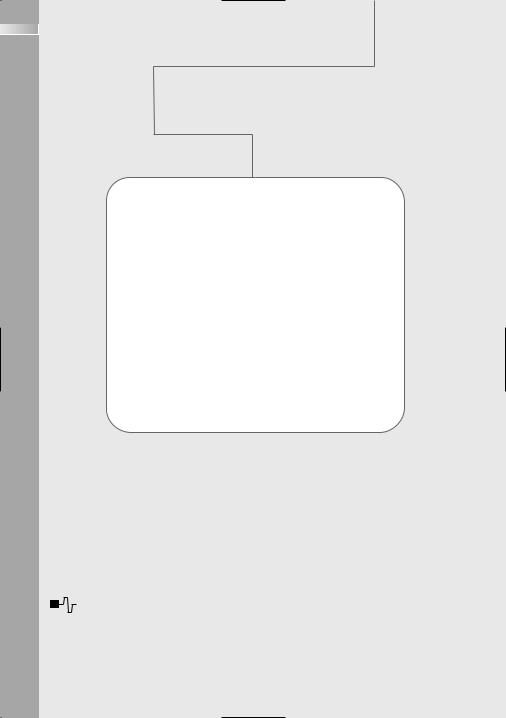
English
Massage category
The programs of the Compex ≥ category subject the muscles of the stimulated region to moderate activity, which produces beneficial
effects that help to improve physical comfort and well-being.
Remaining in the same working position for a long time (for example, sitting in front of a computer screen), conditions of stress, repeated jostling, insufficient muscular conditioning before physical activity are all very frequent situations that are often responsible for uncomfortable bodily sensations.
The automatic progression of the various stimulation sequences, specific to each program of the Massage category, allows each user to adapt the effects of stimulation to his own needs and objectives.
If strong |
be used |
for long |
|
28

Massage
Programs
Relaxing massage
Reviving massage
Toning massage
Effects |
Uses |
Decreased muscular tension
Drainage of the toxins responsible for the exaggerated increase of muscular tone
Effect of well-being and
Considerable increase of blood flow in the stimulated region
Improvement of tissue oxygenation
Activation of blood circulation
Recovery of muscular contractile properties
Invigorating effect
To eliminate uncomfortable or painful sensations, following an exaggerated increase of muscular tone
To contrast effectively sensations of fatigue and localised heaviness
To prepare the muscles in an ideal manner before an unusual/one-time physical activity
29

English
30
Massage
Specific applications
Treatment of uncomfortable muscular tensions in the back of the neck
Remaining in a seated position for long periods, associated with repetitive movements of the upper limbs (as is frequently the case in front of a computer screen), is often responsible for an uncomfortable – or even painful – increase of muscle tension of the back of the neck muscles.
Any other condition of stress may also create situations leading to a state of excessive muscular tension, which is often responsible for painful or uncomfortable sensations.
The in-depth effects produced by the
Relaxing massage program enable to contrast effectively such painful sensations, with a particularly significant result in terms of relaxation.
Cycle duration: To be used on the back of the neck muscles, whenever an occasional sensation of painful muscular tension is felt; to be repeated, if necessary, in cases of particularly strong muscular tension
Program: Relaxing massage 15◊ d
Treatment of a localised sensation of heaviness or an occasional state of fatigue
The many stresses of everyday life are often responsible for uncomfortable, or even painful, physical sensations. A circulation slowdown is often the result of insufficient physical activity, frequently aggravated by the need in one’s working life to remain in the same position for many hours (in a seated position, for example).
Although not serious, this simple “vascular slowdown” is, however, frequently the cause of unpleasant sensations (for example: a sensation of heaviness, often localised in the lower limbs, but also, at times, in another region of the body). The program produces, in the greatest comfort, a reactivation of the blood circulation that allows an acceleration of tissue oxygenation and the elimination of painful sensations, due to insufficient physical effort.
Cycle duration: To be used on the calf muscles, whenever an occasional sensation of heaviness is felt; to be repeated, if necessary, in cases of persistent discomfort
Program: Reviving massage 25◊ j
Muscular and circulation conditioning before physical activity
People who regularly practise sports are well aware of the transition, which is often painful, between a rest activity and an occasional physical effort.
The objective of the usual warming-up techniques is to respond to this need to activate progressively the physiological functions involved in one-time physical activity. This physiological need is also very desirable for moderate but unusual physical efforts, as is frequently the case for most of us (treks, biking, jogging, etc.).
The Toning massage program offers an ideal benefit in the form of optimal muscular and circulation conditioning before any type of physical effort. It allows us to avoid the uncomfortable sensations
– usually experienced during the first few minutes of unusual physical efforts – and to limit the secondary consequences of insufficient preparation (aches, etc.).
Cycle duration: To be used on the muscles most subject to stress in the physical activity involved (in this example: the quadriceps), in the last thirty minutes preceding physical activity
Program: Toning massage 8◊ c
